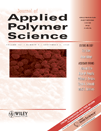Overall properties of fibrillar silicate/styrene–butadiene rubber nanocomposites
Abstract
The mechanical properties, heat aging resistance, dynamic properties, and abrasion resistance of fibrillar silicate (FS)/styrene butadiene rubber (SBR) nanocomposites are discussed in detail. Compared with white carbon black (WCB)/SBR composites, FS/SBR composites exhibit higher tensile stress at definite strain, higher tear strength, and lower elongation at break but poor abrasion resistance and tensile strength. Surprisingly, FS/SBR compounds have better flow properties. This is because by rubber melt blending modified FS can be separated into numerous nanosized fibrils under mechanical shear. Moreover, the composites show visible anisotropy due to the orientation of nanofibrils. There is potential for FS to be used to some extent as a reinforcing agent for rubber instead of short microfibers or white carbon black. © 2006 Wiley Periodicals, Inc. J Appl Polym Sci 101: 2725–2731, 2006




